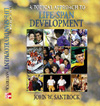 |  Life-Span Development: A Topical Approach John W. Santrock
Cognitive Processes and Development Language Development
Learning Objectives1.Define language as a form of spontaneous, written, or signed communication based on a system of symbols and characterized by infinite generativity. |
 |  |  | 2.Understand language's rule systems, including phonology, morphology, syntax, semantics, and pragmatics. |
 |  |  | 3.Explain the strongest evidence for biological influences on language, such as its universal timetable around the world, its evolutionary advantage, areas of the brain where language is processed, Chomsky's language acquisition device, and the controversy concerning a critical period for developing language. |
 |  |  | 4.Describe the behavioral and environmental influences on language, noting that the behavioral view has not been supported, although adults guide children's language in many ways, including infant-directed speech, recasting, echoing, expanding, and labeling. |
 |  |  | 5.Explore the interactionist view of language development, such as Chomsky's LAD and Bruner's LASS, noting that the interactionist approach emphasizes the contributions of both biology and experience. |
 |  |  | 6.Describe language development in infancy, moving from the newborn's cries, to babbling, one-word utterances, and two-word utterances, noting the dramatic increase in receptive vocabulary in the second year of life and looking at Roger Brown's use of MLUs as an index of language development. |
 |  |  | 7.Discuss language development in early childhood, including the advances in rule systems (phonology, morphology, syntax, semantics, and pragmatics) and the three important sequential frameworks that develop in early language, which are emergence of words and basic vocabulary, transition to combining words and phrases into simple sentences, and the transition to complex sentences. |
 |  |  | 8.Present the basics of language development in middle and late childhood, including:- elementary school children become more analytical and logical in their approach to words and grammar
- the current debate in reading focusing on the whole language versus basic-skills-and-phonetics approach
- the emergence of children's writing out of scribbling, noting how advances in language and cognitive development provide the underpinnings for improved writing
- the issues of bilingualism, noting that it does not interfere with performance in either language and that success in learning a second language is greater in childhood than at a later time
|
 |  |  | 9.Understand the language changes in adolescence, such as increased vocabulary, increased understanding of the function that a word plays in a sentence, understanding metaphor and satire, and writing.
10. Explore the issues of language development in adulthood, with little decline in late adulthood that may occur in relation to declines in hearing, memory, and/or disease. |
|



 2002 McGraw-Hill Higher Education
2002 McGraw-Hill Higher Education